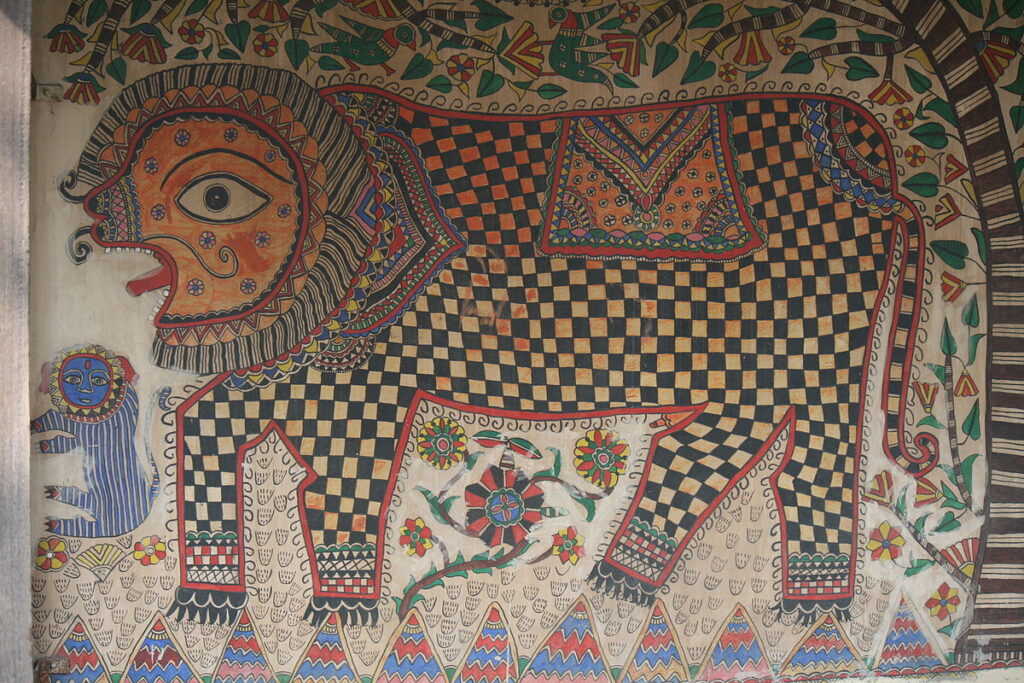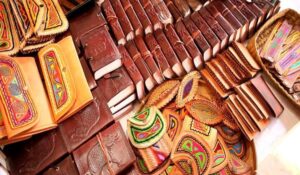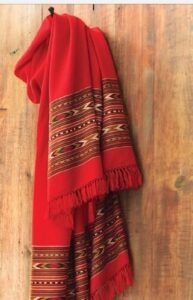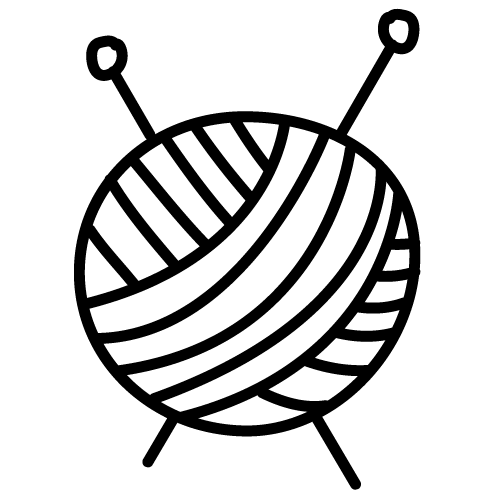Everything you need to know about the ever-evolving
Madhubani Art.
The historic Madhubani art of the Indian Subcontinent has reached global platforms now.
It has evolved from ancient paintings depicting gods to being used as a delicate tool for design.
Madhubani Art originated in Mithila or modern-day Bihar region of the Indian Subcontinent.
It evolved from wall paintings in the small town of Bihar to be a refined part of modern art and design.
This kind of artwork is known for its detailed geometrical patterns.
The artwork and paintings originated from a place define its culture and traditions extensively.
Madhubani is a 2500-year-old folk art that was used to depict holy figures and events from Hinduism.
However, not all folk art and traditions survive the evolution to these contemporary times.
Due to our habit of sticking our head into screens, many artforms have ceased to exist.
However, Madhubani Art was successful in surviving to this age.
By doing so it has expanded its influence into social issues.
Many artists use Madhubani to express their opinions and struggles.
It is an inexplicable part of Indian art and culture.
So, how and where did this folk art originated?
Stay with me and you will discover everything you have to about Madhubani Art.
Where did Madhubani Art originate?
Let’s start from the basics, the origin of Madhubani Art.
This form of art originated from the district of Madhubani in the Mithila region of the Indian subcontinent.
This part is now located in the Bihar state of India.
Wall art was the main form of this art form.
Women used to paint the walls of their houses with Madhubani which was believed to bring prosperity and peace.
Mythologically, it is believed that Madhubani Paintings date back to Ramayana.
They originated when Janaka asked artists to celebrate and capture the wedding of his daughter Sita with Lord Rama.
Madhubani was traditionally done on mud walls and floors of huts.
They depicted religious figures, deities from historic epics and Indian mythology.
This art form quickly turned into a legacy that was passed down from generations to generations by mostly women.
It is still kept alive and traditionally practised in institutions across the Mithila region in Bihar and parts of Nepal.
Darbhanga, Aaidehi, Benipatti are the hotspots for Madhubani art in Bihar.
There is no doubt that Madhubani art is an extremely important part of India’s history and culture.
However, Madhubani Paintings were not exactly discovered by Indians. Let’s dig into the story of how and when was this artform discovered?
When was Madhubani Art discovered?
Madhubani paintings were discovered in British India.
It took an Englishmen to reveal this art form to India and the rest of the world. Ready for a short story?
Bihar suffered a major earthquake in 1934. Willian Archer, a British officer came to inspect the damages in the Madhubani District.
While inspecting the damaged houses, he noticed Madhubani paintings on walls and floors.
He took the first-ever known pictures of this artform.
He later published an article in Indian art Journal, Marg, in 1949.
His observations and pictures presented Madhubani into the attention of the world.
What are the different forms of Madhubani Art?
Madhubani is known for its diversity of patterns and styles.
There are mainly five different forms of this legendary art form: Bharni, Kachni, Tantrik, Godna and Kohbar.
In the 1960s, Bharni, Kachni and Tantrik styles were mainly done by ‘upper-caste women’ in India.
Their paintings consisted of gods and goddesses while those done by the ‘lower-caste’ women depicted their struggle and work.
However, with constant globalization, this art form is no longer rooted in the caste system.
There is no division of any form of Madhubani.
Now, are you also curious about the materials that were used to make these paintings and how they are made now?
Let’s find out!
What are the raw materials used for Madhubani Art?
Before globalization took over Madhubani, there was no use of synthetic materials in it unline now.
Now, Madhubani paintings are done on paper, canvases and cloths by using acrylic paints and watercolours.
Earlier, Madhubani paintings were made from powdered rice.
The colours were derived from natural plants. Ochre, red and Lampblack were used for different shades of red and brown.
Handmade paper and Madhubani Art.
While reading about all the bases that Madhubani art is done on, you might also think that canvas is the best.
It is long-lasting and its quality is far better than a piece of paper.
This is not the case when it comes to Madhubani Art.
People specializing in this art form make these paintings on the traditional handmade paper.
Artists use neem extract to treat this paper.
It not only gives it a distinct stained background but keeps it safe from pests and insects.
To make it safer, an additional mild solution of cow dung is also applied on its surface.
Hence, Madhubani paintings made traditionally on this handmade paper do not get damaged in the long run.
That’s enough about the origin and style of Madhubani.
Let’s discuss more about how this art has been adapted and practised in the present time.
How is Madhubani art practised in the present time?
The women of Ranti Village in Bihar still continue to practice Madhubani Art.
There are generations of women present in this region that have worked hard to keep this tradition alive.
They are teaching other women and girls this Mithila or Madhubani art and way of life.
They are teaching them the power of expression and its importance for women in present times.
This art is being used as a powerful feminist tool to aware girls and women on issues like education, empowerment and liberty.
These girls paint on topis that interests them and hold value.
Topic ranging from folktales to environmental issues.
Speaking of environmental issues, have you ever heard of those hundreds of trees that were saved by Madhubani Art?
If not, let’s find out about them.
How did Madhubani Art save a forest?
In 2012, under the guidance of Shashthi Nath shah, hundreds of trees of a forest cover were painted with Madhubani.
Gram Vikas Parishad Ngo run by Shashthi Shah organised this in an attempt to stop the deforestation that was taking place in the name of development.
This created awareness among the villagers in Bihar about ill-effects of deforestation on the climate and environment.
Surprisingly, their attempt was successful and not a single tree painted with Madhubani was taken down.
They were painted with the figurines of gods and goddesses including the tales of Ramayana and Mahabharata.
Hence, Madhubani saved that forest and allowed people to know more about the environmental changes of deforestation.
As you have read, this art form is just not limited to plastered walls of mud huts now.
It has become a powerful tool of influence and education among masses.
It has travelled the world and made its mark.
Madhubani patterns are everywhere. Let’s see their influence beyond paintings and into the world.
How is Madhubani Art used beyond paintings?
Madhubani has travelled from Bihar into countries like the USA, Russia, Japan, Australia and many more.
The geometric and delicate patterns of Madhubani have found their way into the decor and personal items of various kinds.
Tote bags, coffee mugs, wall hangings, coasters, cushion covers are only a few examples.
This whole journey started when women of Mithila were encouraged to spread the influence of their art and earn from it.
They started doing Madhubani paintings on handmade paper for All India Handicrafts Board.
Soon, the world adapted these geometric patterns of Madhubani into commercial goods.
Madhubani Art has also found its way into the apparel industry.
Its paintings and patterns are printed on several clothes, borders, dupattas, etc.
This art form has been successful in adapting and evolving its way into these contemporary times.
How is Madhubani connected to Feng Shui?
Believe it or not, Madhubani art is filled with symbols and patterns that have a strong resemblance with the Feng Shui philosophy.
Here are a few points of resemblance between the two-
- Birds are used in Madhubani Art associated with the tree of life. Similarly, they are considered a symbol of divinity and spirituality in Feng Shui.
- In both Madhubani Art and Feng Shui, flowers are the symbol of good fortune and luck. They radiate beautiful and positive energy.
- The fishes in Madhubani art are a symbol of fertility and prosperity. In Feng shui, they are known to bring good luck.
- Turtles are also associated with vitality both in Madhubani art and Feng Shui.
Hence, one can say that this art and Feng shui philosophy are connected in several ways.
If you are bringing Madhubani art in any form into your home, it brings the added benefit of Feng Shui.
This was everything I thought you should know about Madhubani Art.
It is an indispensable part of Indian history and culture.
Its ever-evolving nature has taught us that Madhubani is more of a legacy than just paintings,
This art form is a powerful form of expression for people whose voices were never heard.
Women and people from rural areas who struggled to be seen have slowly influenced the world with their art.
If you think we missed something about Madhubani Art, let us know in the comments section below.
You can ever drop in your suggestions on the kinds of art forms and craftworks you would like us to cover in future.
How to know the originality?
- Try not to fall for heavy discounts.
- High-quality shawls are frequently really estimated so discounts are not reasonable.
- So in case you’re getting overwhelming discounts, odds are you are not getting a genuine item.
- Maintain a strategic distance from referrals from Taxi drivers.
- They frequently get enormous commissions to allude vacationers to purchase production line made shawls/stoles.
- Or maybe ask some nearby individual or retailer.
- The majority of the original Kullu shawls sellers are a piece of some enlisted society so you can get some information about it and if they are enrolled under one, at that point it is protected to purchase from them.
- Rundown of barely any notable social orders are given underneath in next segment.
- Government has given a Geographic Indicator(GI) to unique Kullu Shawls.
- So you can get some information about it, yet it is not normal and not many societies have gotten it so it is anything but an inert method to affirm the genuineness of Kullu Shawls.
What are the problems associated with marketing?
Shocking state of marketing framework in the valley is an urgent issue of the local cloak industry.
The shawl weavers think that its hard to contend with the machine-made wraps of Ludhiana.
Subsequently, they do not get sensibly paid.
Because of the absence of mindfulness, business enterprise and appropriate channels focussing on export the nearby weavers need to confront merciless rivalry inside the valley.
Genuine endeavours should be made on part of the legislature for granting most recent specialized ability of the weaving machines improving the status of weavers of the valley.
Did we miss something?
Let us know in the comments down below!













